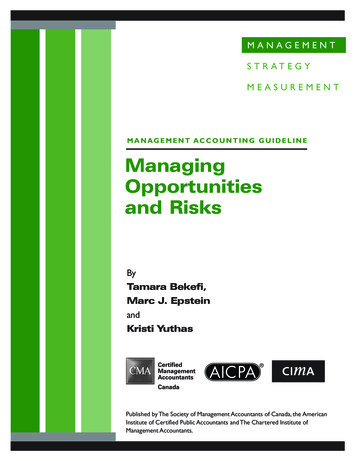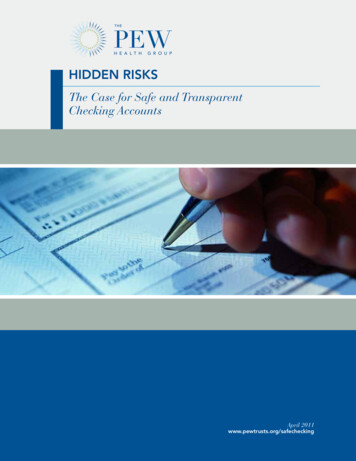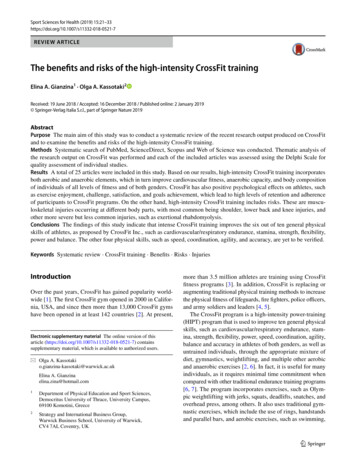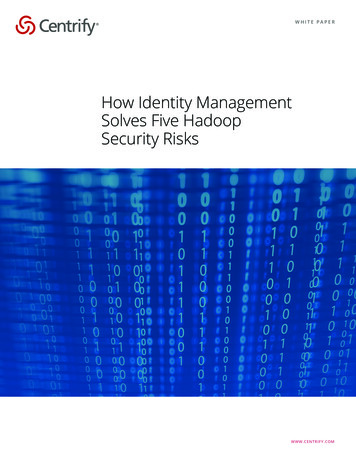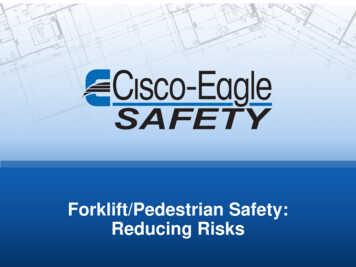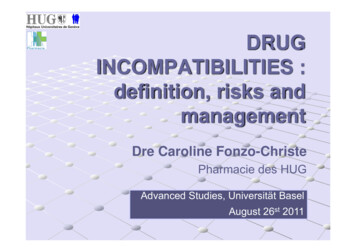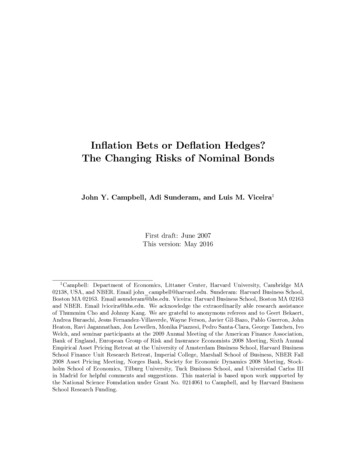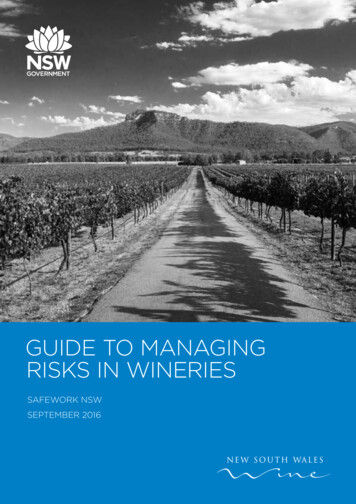
Transcription
GUIDE TO MANAGINGRISKS IN WINERIESSAFEWORK NSWSEPTEMBER 2016
DisclaimerThis publication may contain information about the regulation and enforcement of work health and safety in NSW. It mayinclude some of your obligations under some of the legislation that SafeWork NSW administers. To ensure you comply withyour legal obligations you must refer to the appropriate legislation.Information on the latest laws can be checked by visiting the NSW legislation website www.legislation.gov.auThis publication does not represent a comprehensive statement of the law as it applies to particular problems or to individualsor as a substitute for legal advice. You should seek independent legal advice if you need assistance on the application of thelaw to your situation.This material may be displayed, printed and reproduced without amendment for personal, in–house or non–commercial use.Catalogue No. SW08424SafeWork NSW, 92–100 Donnison Street, Gosford, NSW 2250Locked Bag 2906, Lisarow, NSW 2252 Customer Service Centre 13 10 50Website www.safework.nsw.gov.au Copyright SafeWork NSW 0118
CONTENTS1.Introduction 51.1What are winery operations? 51.2Who should use this guide? 51.3 Who has duties under the lawwithin the wine industry? 62. How can risks within the wine industryoperations be managed 72.1 The hierarchy of risk controlin summary 108. Fire and explosion risks 9. Hot work 9.14041Identifying ignition sources 429.2 Control measures to minimise fireand explosion risks in the winery 4310. Confined space 10.1 How to determine whethera space is a confined space 444610.2 Common risks from working inconfined spaces in wineries include: 473. Consulting, co-operating andcoordinating activities with otherduty holders 144. Induction 165. Information instruction trainingand supervision 176. Injury and incident recording 187. Hazardous chemicals 1910.3 Emergency proceduresand confined space 11. Electrical safety 535511.1 Inspection and testing ofelectrical equipment 5511.2 Keeping records 5611.3 Electrical work on energisedelectrical equipment 5711.4 Residual current devices 577.1 Labelling of workplace hazardouschemicals 2011.5 Requirements for RCDs 587.2Code of practice for labelling 2011.6 Testing of residual current devices 597.3Safety Data Sheets (SDS) 2111.7597.4 Workplaces – safety data sheetsand labelling 2411.8 Overhead and undergroundpower lines 7.525Register of hazardous chemicals 7.6 Duties of PCBUs relating tohazardous chemicals 25Specific hazards and risk control 12. Managing risk of falls 12.1Portable ladders 59606212.2 Selecting ladders 622612.3 Positioning ladders 62Function of placards 2612.4 Access or egress 62Application of placards 2712.5 Safe use of ladders 632712.6 Fixed ladders 6412.7 Fall arrest systems 657.7 Placarding for storage ofhazardous chemicals 7.87.97.10 Definitions 7.11 Hazardous chemicals – assessingrisks 39
6623. Confined space entry permit 11112.9 Hazards with individual fall arrestsystems 6624. Electrical equipment register 11525. Work health and safety – hazardouschemicals register 11626. Reference materials 11712.8 Individual fall-arrest systems 12.10 Anchorage lines or rails 6713. Machinery plant and equipment 6813.1Safety guarding 6913.2 Guarding of grape crushers 6913.3 Maintenance and inspectionof grape crushers 7013.4 Maintenance cleaning and repairof plant within the winery 7013.5 Steps to isolate plant withinthe winery 7113.6 Registering plant 7613.7 Design registration 7613.8 Item registration 7614. Hazardous manual tasks 7714.1 What is a musculoskeletal disorder(MSD)? 7714.2 What is a hazardous manual task? 7814.3 How to identify hazardousmanual tasks 7814.4 Assessing the risks 7915. Emergency arrangements withinthe winery 8816. First aid 9017. Working in heat 9218. Cellar door work health and safety 9619. Traffic management at the winery 9820. Noise at work 10021. Checklist for emergency plans 10422. Incident and injury report 107
1. INTRODUCTIONIn consultation with industry, SafeWork NSW and the NSW Wine Industry Association and its membershave contributed to the development of this guide. This guide provides practical guidance for personsconducting a business or undertaking and workers on managing health and safety risks within thewinery. It should be read in conjunction with other codes of practice relevant to wine production work.1.1 WHAT ARE WINERY OPERATIONS?These operations can be grouped into: wine production bottling packaging storage sales and distribution.1.2 WHO SHOULD USE THIS GUIDE?The Guide applies to all businesses or undertakings within the winery. It can be used where any of theactivities mentioned above are carried out at a workplace.It is intended that this guidance document should be read and used in conjunction with the specificwork health and safety codes of practice which provide additional practical guidance and informationon how you can achieve the standards required under the work health and safety laws. These areavailable on the SafeWork NSW and Safe Work Australia websites.Traffic light tables are also used in this guide to indicate which practices are high risks and alertyou to what the preferred risk controls are. Reduced risk solutions are indicated where an interimarrangement is necessary or if the preferred solution is assessed as not being reasonably practicablein an individual situation.It is recognised that equivalent or better ways of achieving the required work health and safetyoutcomes may be possible. For that reason compliance with Codes of Practice is not mandatoryproviding that any other method used provides an equivalent or higher standard of work healthand safety than suggested by the Code of Practice.GUIDE TO MANAGING RISKS IN WINERIES5
1.3 WHO HAS DUTIES UNDER THE LAWWITHIN THE WINE INDUSTRY?Everyone in the workplace has a work health and safety duty. The main duties are set out in Table 1.Table 1 – Duty holders and their obligationsWhoDutiesProvisionsA person whoconducts a businessor undertaking Ensure, so far as is reasonably practicable,workers and other people are not exposed tohealth and safety risks arising from the businessor undertaking. Eliminate health and safety risks so far asis reasonably practicable, and if this is notreasonably practicable, minimise those risks so faras is reasonably practicable. This includes risks associated confined space,hot work, hazardous manual tasks, plant andmachinery, hazardous chemicals, electricity, noise,risk of falls, hot and cold environments, publicsafety, etc.WHS Acts 19WHS Regulationsr 35Designers,manufacturers,importers, suppliersor installers of plantor substancesEnsure, so far as is reasonably practicable, the plantor substances they design, manufacture, import orsupply is without risks to health and safety, includingcarrying out testing and analysis and providinginformation about the plant or substances.WHS Acts 22–26Officers such ascompany directorsExercise due diligence, including by takingreasonable steps to ensure the business orundertaking has and uses appropriate resourcesand processes to eliminate or minimise risks fromwork associated with growing, processing, storage,transporting, sales of wine industry products.WHS Acts 27Workers Take reasonable care for their own healthand safety. Take reasonable care not adversely affect otherpeople’s health and safety. Co-operate with reasonable work health andsafety policies or procedures. Comply, so far as they are reasonably able, withreasonable instructions.WHS Acts 28Other persons atthe workplace,like visitors Take reasonable care for their own healthand safety. Take reasonable care not to adversely affect otherpeople’s health and safety. Comply, so far as they are reasonably able,with reasonable instructions.WHS Acts 296SAFEWORK NSW
2. HOW CAN RISKS WITHIN THE WINE INDUSTRYOPERATIONS BE MANAGEDUse the following steps to ensure, so far as is reasonably practicable, that workers and otherpeople are not exposed to health and safety risks:Many hazardous activities carried out in the wine industry can result in death or serious injuryif not managed correctly.STEP ONEFind out what could cause harm. Hazards generally arise from three parts of the wine productionindustry and their interaction. These are: the physical work environment machinery, processing and substances used, and work practices and systems of work.Typical hazards found in wine production, these are: confined space hot work hazardous manual tasks plant and machinery hazardous chemicals electrical noise fatigue risks of falls exposure to extremes of temperature and cold hit by moving objects traffic management visitor and customer access.Table 2 overleaf lists some potential types of workplace hazards. Some hazards are part of the workprocess, such as mechanical hazards, noise or toxic properties of substances. Other hazards resultfrom equipment or machine failures and misuse, chemical spills and structural failures.A piece of plant, substance or a work process may have many different hazards. Each of thesehazards needs to be identified. For example, a production line (packaging/bottling locations) mayhave dangerous moving parts, noise, hazards associated with manual tasks and psychological hazardsdue to the pace of work.GUIDE TO MANAGING RISKS IN WINERIES7
Table 2 – Examples of different types of hazards which may exist within wineriesHazardPotential harmManual tasksOverexertion or repetitive movement can cause muscular strainGravityFalling objects, falls, slips and trips of people can cause fractures, bruises,lacerations, dislocations, concussion, permanent injuries or deathElectricityPotential ignition source. Exposure to live electrical conductors mayresult in electrical shock, burns or death from electrocutionMachinery and equipment Being hit by moving vehicles, or being caught by moving parts ofmachinery can cause fractures, bruises, lacerations, dislocations,permanent injuries or deathHazardous chemicalsChemicals such as anhydrous ammonia (irritant corrosive) can skin, eyes,respiratory tract; chemical burns, carbon dioxide (Asphyxiant) affectsrespiratory/nervous system, sulphur dioxide affects and causes irritationof the eyes and the respiratory tract.Extreme temperaturesHeat can cause burns, heat stroke or fatigue. Cold can causehypothermia.NoiseExposure to hazardous noise can cause noise induced hearing lossRadiationUltra violet, welding arc flashes, micro waves and lasers can cause burns,cancer or blindnessBiologicalMicro-organisms can cause hepatitisPsychosocial hazardsEffects of work related stress, bullying, violence and work related fatigue.Glass/productsLacerations from handling of broken glass materials/productsSTEP TWOAssess the risk. In many cases the risks and related control measures will be well known. In other casesyou may need to carry out a risk assessment to identify the likelihood of somebody being harmed bythe hazard and how serious the harm could be. A risk assessment can help you determine what actionyou should take to control the risk and how urgently the action needs to be taken.Table 2. Shows for example, common activities, hazards and risks which may exist within the winery.With each of these risks an assessment of the working conditions should be done to identify waysto eliminate or minimise risks in the high risk zone and ensure the activity is in the medium or lowerrisk zones.8SAFEWORK NSW
Table 3 – Assessing risks in the wineryHazards andactivitiesWine production risk profileOperatingmachinery Workers operate Workers have somemachinery withouttraining or trainingtraining or assessment,which is not currentfor example, Operationor relevant to theof Forklift Truck withoutmachinery they areHigh Risk Licenceoperating. has only been assessedinformally Workers have beentrained and assessed onthe machinery they areoperatingWorkers havebeen assessed forcompetence andattained their HRWlicence for FLTHazardousmanual tasks Workers manuallylifting heavy boxescontaining productonto pallets Workers utilise theuse of fork lift trucksor pallet jacks to loadpallets/trucksHigher riskLower risk Workers have receivedtraining in safe manualhandling techniquesWorking alone Working alone withoutin remote partsemergency proceduresof winery Working alone with Working alone butagreed emergencywithin the same areacontact and proceduresas others in constantcommunication withestablished emergencyarrangements.Use ofhazardouschemicals Handling of caustic oracidic chemicals wherethere is a potential forsplashes onto the skinor eyes Safe work practices Consider installingdeveloped andautomated systems toimplemented to avoiddispense or transferskin contact, or selectchemicals betweenand use appropriatecontainers. Use eyePPE to control exposureprotection. Provide anemergency eyewashfacility.Electrical(risk ofelectricalshock, orelectrical fire) No electrical inspection, Inspection and testingtesting and tagging ofof electrical plantelectrical plant suchundertaken, records ofas electrical leads, andinspection and testingportable electricalretained.tools such as electricaldrills. No records ofinspection or testing.Noise Workers using personalhearing protectors Residual currentdevices installed onelectrical switchboardprotecting GPOssupplying electricalplant. Electrical plantinspected testedtagged Records of inspectionand testing retained. Use of extra low voltageequipment modify plant and isolate the source ofprocesses to reduce thenoise from peoplenoise using engineeringby using distance,controlsbarriers, enclosuresand sound absorbingsurfaceGUIDE TO MANAGING RISKS IN WINERIES9
STEP THREETake action to control the risk. The work health and safety laws require a business or undertakingdo all that is reasonably practicable to eliminate or minimise risks.The ways of controlling risks are ranked from the highest level of protection and reliability to thelowest. This ranking is known as the hierarchy of risk control. You must work through this hierarchyto manage risks.The first thing to consider is whether hazards can be completely removed from the workplace. If it isnot reasonably practicable to completely eliminate the risk then consider the following options in theorder they appear below to minimise risks, so far as is reasonably practicable: substitute the hazard for something safer, for example, use a non-caustic cleaner insteadof caustic soda isolate the hazard, for example, installation of fixed ladders/walkways on top of tanks, install guardrails around exposed edges and holes in floors.If after implementing the above control measures a risk still remains, consider the following controlsin the order below to minimise the remaining risk, so far as is reasonably practicable: use administrative controls, for example, rotate jobs and vary tasks to minimise the risks associatedwith repetitive manual handling tasks, and use personal protective equipment (PPE), for example,safety eyewear, hearing protection, safety helmets, or reflective, high-visibility clothing.A combination of the controls set out above may be used if a single control is not enough to minimisethe risks. You need to consider all possible control measures and make a decision about which arereasonably practicable for your workplace. Deciding what is reasonably practicable includes theavailability and suitability of control measures, with a preference for using substitution, isolationor engineering controls to minimise risks before using administrative controls or PPE. Cost may alsobe relevant, but you can only consider this after all other factors have been taken into account.STEP FOURCheck your control measures regularly to ensure they are working as planned. The nature of the work,the work processes and working conditions including the environment means risk control measuresmay require regular reviewing to deal with changes in working conditions. Control measures need tobe regularly reviewed to make sure they remain effective, taking into consideration any changes, thenature and duration of work and that the system is working as planned.Further information on the risk management process is in the Code of Practice: How to manage workhealth and safety risks.2.1 THE HIERARCHY OF RISK CONTROL IN SUMMARYThe most important step in managing risks involves eliminating them so far as is reasonablypracticable, or if that is not possible, minimising the risks so far as is reasonably practicable. In decidinghow to control risks you must consult your workers and their representatives who will be directlyaffected by this decision. There are many ways to control risks. Some control measures are moreeffective than others.10SAFEWORK NSW
You must consider various control options and choose the control that most effectively eliminatesthe hazard or minimises the risk in the circumstances. This may involve a single control measureor a combination of different controls that together provide the highest level of protection that isreasonably practicable. Some problems can be fixed easily and should be done straight away, whileothers will need more effort and planning to resolve. Of those requiring more effort, you shouldprioritise areas for action, focusing first on those hazards with the highest level of risk. The waysof controllingFigure 1 – Hierarchy of control taken from How to Manage Work Health and Safety Risks Code of PracticeLOWESTLevel 1Eliminate the hazardsLevel 2Substitute the hazard with something saferIsolate the hazard from peopleReduce the risks through engineering controlsLevel 3Reduce exposure to the hazardusing administrative actionsUse personal protective equipmentMOSTReliability of control measuresLevel of health and safety protectionHIGHESTLEASTExample – Controlling the risk of falls whilst accessing the top of tanks to take wine samples.The installation of a fixed ladder (engineering control) and/or walkway has reduced the risk of falls.This task could have been eliminated by installing test taps at the bottom of the tanks.You must always aim to eliminate a hazard, which is the most effective control. If this is not reasonablypracticable, you must minimise the risk by working through the other alternatives in the hierarchy.The following table summarises the types of controls in the hierarchy as prescribed in thework health and safety legislation.Photograph shows exampleof modifications madeto large wood tank byinstallation of a test tapnear base.GUIDE TO MANAGING RISKS IN WINERIES11
The following table 4 summarises the types of controls in the hierarchy as prescribed in thework health and safety legislation.Table 4 – Hierarchy of controlType of controlCommentsEliminatingEliminating the hazard is the most effective means of managing a risk.It must be considered before all other control ng controlsWhere it is not reasonably practicable to eliminate a hazard, risks arisingfrom the hazard must be minimised.Substitution, isolation and engineering controls have the same ranking inthe hierarchy. Their effectiveness does not depend on human behaviourAdministrative controlsIf a risk remains, the risks must be controlled using administrative controlssuch as safe work procedures and training personnel.The effectiveness of administrative controls depends on human behaviourUsing Personal Protective If a risk remains, the risks must be controlled using PPE. This is the leastControls (PPE)effective measure and also depends on human behaviourNote. A combination of the controls set out in this clause may be used to minimise risks, so far as isreasonably practicable, if a single control is not sufficient for the purpose. This is often the case.Please refer How to Manage Work Health and Safety Risks Code of PracticeThis code provides practical guidance for persons who have duties under the WHS Act andRegulations to manage risks to health and safety.A rack used to storehoses, prevent triphazards and damagewhile not in use.12SAFEWORK NSW
A result of poor organisationwhere hoses cause a triphazard to workers involved intransferring/pumping operations.Retrofitting of overhead fixed lineshelps to reduce trip hazards andimproves efficiencies to enablemanoeuvrability of other plant andequipment at this location.GUIDE TO MANAGING RISKS IN WINERIES13
3. CONSULTING, CO-OPERATING ANDCOORDINATING ACTIVITIES WITH OTHERDUTY HOLDERSConsultation involves sharing information, giving workers a reasonable opportunity to express viewsand taking those views into account before making decisions about health and safety matters.Consultation with workers and their health and safety representatives is required at each step of therisk management process. By drawing on the experience, knowledge and ideas of your workers youare more likely to identify hazards and choose effective control measures. You should encourageyour workers to report hazards and health and safety problems immediately so the risks can bemanaged before an incident occurs. There is often more than one business or undertaking involvedin wine production.Each has responsibility for health and safety to the extent they influence and control aspects of thewinery. If there is more than one business or undertaking involved at your workplace you must consultthem to find out who is doing what and work together so risks are eliminated or minimised so far as isreasonably practicable. Because contractors and labour hire workers may be carrying out work at thewinery it is necessary to include them in these consultative arrangements. Consultation arrangementsshould take into account the size of the winery, the way work is arranged, shifts, workgroup locations,mobile workers, etc. Many organisational decisions or actions have health and safety consequences forworkers. For example, introducing a new crusher equipment into the workplace may affect the tasksyour workers carry out, the timeframes for doing work, how they interact with each other and theenvironment in which they work.A person conducting a business or undertaking must consult with workers when: identifying hazards and assessing risks arising from the work carried out or to be carried out making decisions about ways to eliminate or minimise those risks making decisions about the adequacy of facilities for the welfare of workers proposing changes that may affect the health or safety of your workers, and making decisions about procedures for consulting with workers; resolving health or safety issues;monitoring health of your workers; monitoring the conditions at the workplace and providinginformation and training for your workers.For further guidance on consultation requirements is available in the Code of Practice Work health andsafety consultation, co-operation and co-ordination.14SAFEWORK NSW
The development of a Safe Work Procedure, for example, to safely operate the crushing plant,should be done in consultation with the respective parties, such as workers and contractors.This will assist in the identification of the operational hazards, and the associated risks.Involving and consulting your workers, they will be more likely to follow a safe work procedureif they have been involved in its development, and they will often know the best and safest waytoperform a task. Involve those workers who are experienced in performing the tasks.GUIDE TO MANAGING RISKS IN WINERIES15
4. INDUCTIONIn addition to task-specific training, workers undertaking work within the winery and associated workoperations must be provided with induction training to inform them of site-specific hazards and tofamiliarise them with winery operations and safe work procedures. Induction training should includebut not limited to: hazard identification and risk control site-specific winery hazards site safety rules isolation of plant hazardous manual tasks and safe lifting techniques emergency procedures safe work procedures communication systems first aid and amenities fatigue management hazard and incident reporting record keeping consultation arrangements and issue resolution processes.16SAFEWORK NSW
5. INFORMATION INSTRUCTION TRAININGAND SUPERVISIONAll PCBUs, subcontractors and self-employed persons (for example, sole traders) must providerelevant information, training, instruction and supervision to protect all persons from risks to theirhealth and safety arising from work carried out within the winery. Information relevant to the healthand safety of workers should be available in the workplace. This includes information about the safeuse of plant, equipment and hazardous chemicals that are used in the workplace. Wineries have a dutyto provide information, training and instruction to your workers so that they know how to work safelyand without risk to their health.It is the wineries duty to provide clear information, training and instruction that covers: the type of work carried out by the worker the type of risks associated with that work the safety measures taken to reduce (or manage) risks in the workplace.Safety signs provide information in the workplace, however the use and reliance on signage does notremove the need to provide safe systems of work or other information and training, nor does it transferwork health and safety responsibility to the worker.A range of activities can assist in ensuring people have the necessary knowledge and skills to completethe work safely, including general induction training and other training that may be specific to theworkplace or the task the person is performing. Information that might be provided includes workplacehealth and safety arrangements and procedures, such as for emergency evacuations/arrangements.Information can be provided in various forms, including written formats or verbally, for example,during workplace-specific training, pre-start meetings or toolbox talks. Information and instruction areoften provided at the same time. In addition, supervisors will provide specific workplace instructionsduring the work, including for health and safety. Supervisors should be aware of and provide the levelof supervision necessary to ensure the health and safety of workers, including checking workers’competency to undertake the work the safely.Induction training programs provides knowledge of winery operations, the work health and safety lawsthat apply, common hazards likely to be encountered in the wine industry, and how the associatedrisks can be controlled. Workers should receive the necessary supervision to ensure work health andsafety. A range of factors will determine what is meant by ‘necessary’. These may include complexityof the task, associated hazards and level of risk, skills, knowledge and experience of the worker, theworkplace and environment and system of work.GUIDE TO MANAGING RISKS IN WINERIES17
6. INJURY AND INCIDENT RECORDINGThe WHS Act requires the regulator (SafeWork NSW) to be notified of certain ‘notifiable incidents’.Notifying the regulator of ‘notifiable incidents’ can help identify causes of incidents and prevent similarincidents at your workplace.The WHS Act, in summary Part 3 of the WHS Act requires: immediate notification of a ‘notifiable incident’ to the regulator after becoming aware of it if the regulator asks – written notification with 48 hours of the request, and preservation of the incident site until an inspector arrives or directs otherwise(subject to some exceptions).Failing to notify is a criminal offence and penalties apply.WHAT IS A ‘NOTIFIABLE INCIDENT’A ‘notifiable incident’ as outlined in the WHS Act is: death of a person ‘serious injury or illness’, or ‘dangerous incident’ arising out of the conduct of a business or undertaking at a workplace.‘Notifiable incidents’ may relate to any person – whether an employee, contractor or memberof the public.Ensure that all incidents and injuries are reported to the supervisor and management staff and arerecorded on the incident and injury report see page 108.Record all incidents in the incident and injury report and provide a copy to managementAuthorities also require that the place of work is ‘not to be disturbed’ except by actions relatingto emergency rescue.18SAFEWORK NSW
7. HAZARDOUS CHEMICALSHazardous chemicals are used extensively within the wine industry. These hazardous chemicals arestored, used and transported within wineries on daily basis. Hazardous chemicals that may be found ata winery include such chemicals as ozone, anhydrous ammonia, copper sulphate, chlorine gas, sodiumhydroxide and carbon monoxide. Caustics are used regularly for cleaning tanks, ammonia is used inrefrigeration systems, diatomaceous earth is used for filtration purposes. Toxic gases can be foundduring fermentation, cleaning and bottling such as sulphur dioxide, hydrogen sulphide, and ammonia.Other common hazardous chemicals used commonly include, nitrogen, ethanol (spirit), which can be invarious forms, for example, gas, liquids, solid. Nationally and within NSW a model Code of Practice hasbeen developed to provide practical guidance on how to manage health and safety risks associatedwith hazardous chemicals for persons conducting a business or undertaking who use chemicals intheir workplace.Safe Work Australia defines a hazardous chemical as any substance, mixture and article that satisfiesthe criteria of one or more of the Globally Harmonised System of Classification and Labelling ofChemicals hazard classes, including a classification referred to in Schedule 6 of the WHS Regulations.Hazards presented by the hazardous chemicals can be classified broadly into two types healthand physicochemical hazards based on the immediate or long term injury or illness to people inthe workplace. Health hazards are hazards like skin irritants, carcinogens or respiratory sensitisersthat have an adverse effect on a worker’s health as a result of direct c
1.2ho should use this guide? W 5 1.3ho has duties under the law W within the wine industry? 6 2.ow can risks within the wine industry H operations be managed 7 2.1he hierarchy of risk control T . in summary 10 3.onsulting, co-operating and C coordinat
